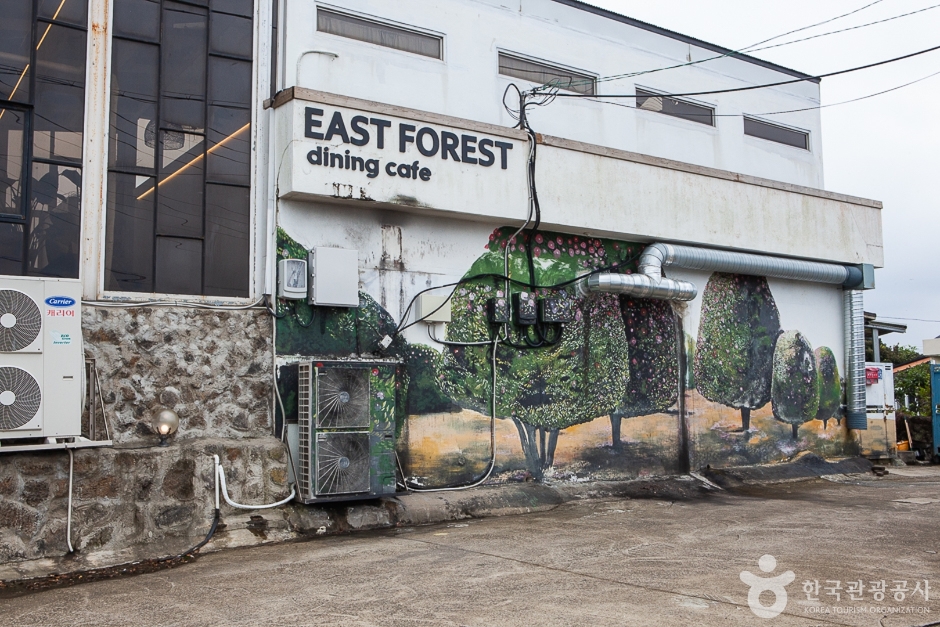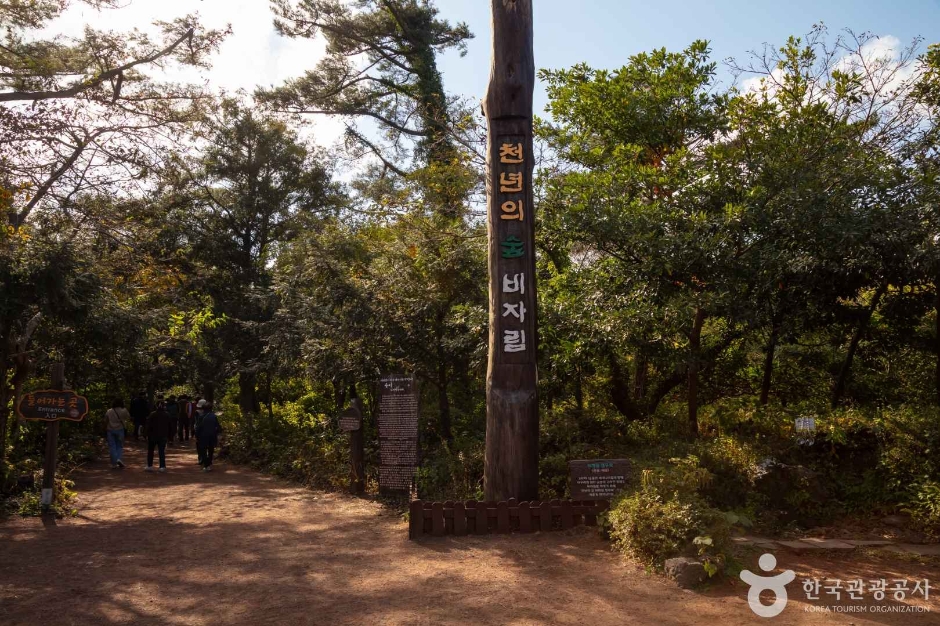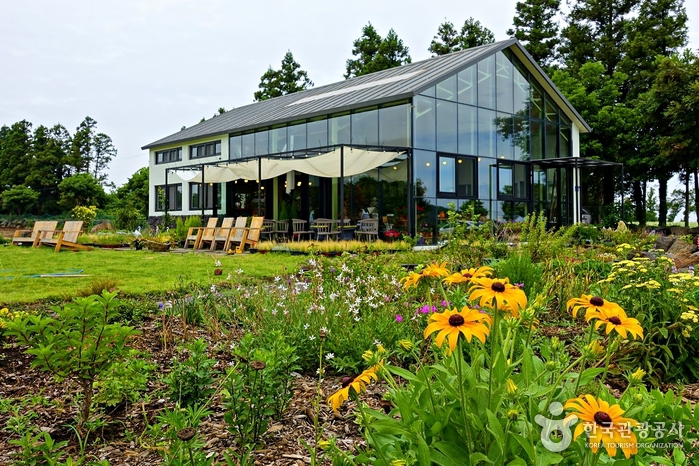East Forest (이스트포레스트)
6.0Km 2024-02-20
26-1 Jongdal-ro 1-gil, Gujwa-eup, Jeju-si, Jeju-do
East Forest is a pasta restaurant in Jeju, known for its pleasant ambiance. Its signature dish is muneo cream pasta (octopus cream pasta). The menu also features other delectable options like jeonbok buttergui risotto (butter-grilled abalone risotto) and haesanmul nurungji tomato pasta (seafood scorched rice tomato pasta). With its stylish interior and tasty offerings, the restaurant has become a favorite among both locals and tourists. Nearby attractions include Hado Beach and Seongsan Ilchulbong Peak.
Bijarim Forest (비자림)
6.3Km 2025-04-01
55 Bijasup-gil, Jeju-si, Jeju-do
+82-64-710-7912
Designated and protected as a Natural Monument, Bijarim Forest is home to 2,800 bija trees, ranging from 500 to 800 years in age, spread over 448,165㎡ land area. These majestic trees range from 7-14 meters in x_height, 50-110 centimeters in diameter, and 10-15 meters in crown x_width, so this forest is quite a rare example of its kind in the world. The berries of bija trees were used widely as a medicine used to kill parasites, while the wood was used to make premium furniture and go boards. Forest bathing in a bija forest helps to combat arteriosclerosis, mitigate physical and psychological fatigue, and restore the body’s rhythm.
Maze Museum (메이즈랜드)
6.5Km 2025-10-23
2134-47 Bijarim-ro, Gujwa-eup, Jeju-si, Jeju-do
+82-64-784-3838
Maze Museum, a comprehensive theme park, features the world's longest stone maze, spanning 5.3 km and themed around Jeju’s Samda—the island’s iconic triad of stones, wind, and women. Proudly showcasing Korea’s natural beauty, the park also houses a museum where visitors can explore the history of mazes, view artifacts, and solve puzzles dating from the 14th century to modern times. Constructed from local stones known for their high far-infrared ray emission and the western arborvitae trees, which release beneficial phytoncides, Maze Museum is an eco-friendly park designed with health benefits in mind, offering more than just walking mazes. The site is enveloped by a variety of 40-year-old trees, providing an ideal environment for forest bathing and immersing in nature.
Yongcheondonggul Cave [UNESCO World Natural Heritage Site] (용천동굴 [유네스코 세계자연유산])
6.6Km 2020-11-27
Woljeong-ri, Jeju-si, Jeju-do
+82-1600-0064
Yongcheondonggul Cave is the most typical form of lava tunnel on Jeju Island and with a total length of approximately 2,470 meters, it is one of the largest. It has a unique topology and rich limestone formations such as lava terrace, lava shelves, lava waterfalls, and 140 meters of lava rolls. In particular, a range of carbonate formations such as straw soda, stalactite, columns, flowstones, cave corals, and aragonite crystals can be found inside this large cave that also contains a lake. This unique cave is astounding in terms of its geological value and beauty. There are also items that can be found throughout the cave that appear to have been brought in by people who lived on the island long ago, such as pieces of pottery, animal bones, ironware, charcoal and other substances.
* The UNESCO World Heritage inscribed Geomunoreum Lava Tube System consists of Bengdwigul, Manjanggul, Gimnyeonggul, Yongcheondonggul and Dangcheomuldonggul Caves.
Gimnyeongsagul Cave [UNESCO World Heritage] (김녕사굴 [유네스코 세계자연유산])
6.7Km 2022-12-29
34, Manjanggul-gil, Jeju-si, Jeju-do
+82-1600-0064
Gimnyeongsagul Cave is located close to Manjanggul Cave in the northeastern part of Jeju Island. The name of the cave, "Sagul," comes from the snake-like formation of the cave ("sa" meaning serpent). The entrance of the cave is wide like a serpent holding its mouth wide open, but once inside, the tunnel narrows resembling the body of a snake. Gimnyeongsagul Cave is a highly protected area and has been designated as Natural Monument along with Manjanggul Cave.
Haenyeo Kitchen (해녀의 부엌)
6.8Km 2025-10-31
2265 Haemajihaean-ro, Gujwa-eup, Jeju-si, Jeju-do
Haenyeo Kitchen is a local food dining space where visitors can enjoy dishes handmade by Jeju's haenyeo (female divers) and performances that unfold their stories. Housed in a renovated old warehouse by the sea, visitors can savor meals prepared by the haenyeo themselves, using Jeju's seafood and bountiful ingredients. The performances here showcase the talent and dedication of young artists working across diverse fields, from spatial design and story development to planning, lighting, music, choreography, and acting, allowing visitors to fully immerse in the world of haenyeo.
Gimnyeong Maze Park (김녕미로공원)
6.9Km 2024-03-13
122 Manjanggul-gil, Gujwa-eup, Jeju-si, Jeju-do
+82-64-782-9266
Gimnyeong Maze Park is intricately designed with towering evergreen trees, each reaching up to three meters in x_height, creating an natural labyrinth. The pathways are paved with scoria, a natural volcanic rock characteristic of Jeju, enhancing the authentic island feel. As visitors navigate the maze, the refreshing scent of evergreen trees fills the air, providing a sense of clarity and rejuvenation. Along the route, visitors can encounter unique dolmens and their feline residents. The park also features an observatory and a suspension bridge, offering breathtaking panoramic views. Gimnyeong Maze Park is a favorite destination for families, children and couples alike, providing a memorable experience for all.
Manjanggul Lava Tube [National Geopark] (만장굴 (제주도 국가지질공원))
7.0Km 2025-03-31
182 Manjanggul-gil, Jeju-si, Jeju-do
Manjanggul Lava Tube, located in Gimnyeong-ri, Jeju, is part of the Geomunoreum Lava Tube system. The lava tube stretches roughly 7,400 meters, with a maximum x_height of 25 meters and x_width of 18 meters. These measurements make it one of the largest lava tubes in the world. Manjanggul holds great value for science and conservation studies, having well-maintained formations despite being formed over one hundred thousand years ago.
The majority of the cave is closed off, with only 1 kilometer being open to tourists. Within this open section, visitors can see a variety of lava tube and cave topographical features, including stalagtites, stalagmites, and stone pillars. Among these, the 7.6-meter-tall stone pillar at the end of the open section is recorded as the largest in the world.
Jeju Railbike (제주레일바이크)
7.6Km 2024-10-31
641 Yongnunioreum-ro, Gujwa-eup, Jeju-si, Jeju-do
Jeju Railbike opened in 2013 and is the only raikbike facility on Jeju Island. While pedaling along, riders can enjoy the views of cows and horses out to pasture in the fields. The full course is 4 kilometers long, and the bikes are all equipped with motors, making it easy for anyone and everyone to complete the full course without breaking a sweat. Jeju Railbike stands out from other railbikes in the use of many up and down sections, as the rails are not previous railroad tracks, but newly created to match the natural terrain of the ranch. After finishing the ride, visitors can enjoy feeding small animals like sheep, goats, and rabbits.
Songdangnamu (송당나무)
8.2Km 2024-02-21
68-140 Songdang 5-gil, Gujwa-eup, Jeju-si, Jeju-do
Songdangnamu is a gardening café where visitors can enjoy flowers in a spacious garden. Songdang-ri, known for its abundant rainfall, is recognized as a neighborhood conducive to plant growth, making it popular for landscaping cultivation. The café features a greenhouse filled with various plants such as herbs, palm trees, and catcus, as well as an outdoor garden spanning over 5,300 square meters. The signature menu item is the hallabong ade.



![Gimnyeongsagul Cave [UNESCO World Heritage] (김녕사굴 [유네스코 세계자연유산])](http://tong.visitkorea.or.kr/cms/resource/37/1618237_image2_1.jpg)
![Manjanggul Lava Tube [National Geopark] (만장굴 (제주도 국가지질공원))](http://tong.visitkorea.or.kr/cms/resource/55/3354155_image2_1.jpg)

 English
English
 한국어
한국어 日本語
日本語 中文(简体)
中文(简体) Deutsch
Deutsch Français
Français Español
Español Русский
Русский